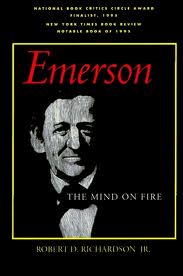Robert D. Richardson, Jr. begins his masterful biography of 19th century essayist, lecturer, poet, and Transcendentalist Ralph Waldo Emerson with these lines:
“On March 29, 1832, the twenty-eight-year-old Emerson visited the tomb of his young wife, Ellen, who had been buried a year and two months earlier. He was in the habit of walking from Boston out to her grave in Roxbury every day, but on this particular day he did more than commune with the spirit of the departed Ellen: he opened the coffin. Ellen had been young and pretty. She was seventeen when they were engaged, eighteen when married, and barely twenty when she died of advanced tuberculosis.”[1]
Richardson makes clear that Emerson did not open his wife’s coffin in some sort of “grisly gothic gesture” or in a moment of coming “unhinged.” [2] Other contemporaries of Emerson had similarly opened their loved one’s coffins. Emerson in fact would repeat the act later in life when relocating the coffin belonging to his son Waldo who had died at age five. But the question remains: what could such a seemingly morbid action hope to achieve?
A precise answer to this question is not to be found in Emerson’s otherwise copious journals. However, when Richardson returns to this incident later in the biography, he states that the effect the March visit had on Emerson is clear:
“[Emerson] was casting off old ties and embracing new ideas and new possibilities. Coming face to face with the dead forced Emerson to choose between the dead and the living. His sermons for April are insistently this-worldly. He talked on successive Sundays about ‘the virtues near at hand,’ ‘the pleasures near at hand,’ ‘the God of the living.’”[3]
To quote first Richardson and then Emerson, after looking in Ellen’s coffin Emerson somehow left the state of ruins in which he had found himself after her death and became “very much open to the world” – a world in which “Every thing is significant.”[4]
Perhaps James Hillman’s “psychology of death” — introduced last week — may yield further insight into both Emerson’s decision to look inside his wife’s coffin and his consequent rebirth out of emotional and psychological ruin. In the pages referenced last week, Hillman writes that most of us have very active defenses against death (imaged mythologically as Hades, god of the Underworld). We prefer to avoid considerations of death and mortality, whenever possible giving pride of place to intimations of immortality instead.
While Hillman (like Jung before him) argues that this last, i.e., the idea of an afterlife, is indeed natural and important to humankind, the point is that so too is an awareness of our emotional and bodily mortality here and now. In this vein, Hillman writes that “Death in the soul is not lived forward in time and put off into an afterlife. It is concurrent with daily life as Hades is side by side with his brother Zeus.”[5] According to Hillman, the problem lies in our “defense against Hades,” or, put differently, our “defensive identities with life.”[6] So often we do everything in our power to escape (our fear of) death, preferring instead feelings of excitement and invincibility, hope and possibility. We prefer spirit but forget the equally important and deepening present-minded soul.
To a certain degree, the spirited avoidance of death is behind many of the anxieties and addictive or compulsive behaviors which plague us individually and collectively. We are split off from half of our selves, the half which the ancient Greeks imaged as Hades in the Underworld. Hillman argues that one way to reconnect with this half is to do what many Renaissance writers, thinkers, and artists did, or rather what they did not do: they “never lost touch with disintegration and death,” a fact which enabled them to “let go of all seemingly irreducible objectifications of human personality, whether it be the organic body, the human personality, or subjective awareness [. . .].”[7]
In this and the prior blog, Mythfire has focused on Hades and the riches of the Underworld. However, an equally important component to the myth is Hades’ abduction of Persephone while she was out enjoying the riches, i.e. flowery meadows, of the daylight upper world. Seen from the perspective of the ego, this loss of naïve innocence is a tragedy; seen from the perspective of the soul Persephone’s consequent marriage to Hades and life in the Underworld represents a deepening into one’s soul life. Just as happened to Emerson after he lost his Persephone, awareness of death facilitates a humbling letting go of our egoistic assumptions concerning ourselves and our world so that we might more authentically experience the soulful as well as spiritual dimensions of life — here and now. [8]
——
Next Wednesday: Harry Potter and the Spiritual Dimension of Play
[1] Richardson, Robert D., Jr. Emerson: The Mind on Fire. Berkeley, CA: University of CA P, 1995: 3.
[2] Ibid., 3.
[3] Ibid, 121.
[4] Ibid., 122. Italics added.
[5] Hillman, James. Re-Visioning Psychology. New York: HarperPerennial, 1975: 206. Hillman’s Dream and the Underworld is also essential reading for more on the myth of Hades.
[6] Ibid., 208.
[7] Ibid., 209.
[8] It is in this spirit that Hillman writes: “What is human is frail, subject to death. To be human is to be reminded of death and have a perspective informed by death. To be human is to be soul-focused which in turn is death-focused. Or to put it the other way, to be death-focused is to be soul-focused.” (Re-Visioning, 207). Finally, one cannot help but wonder if Emerson associated Ellen’s death with Persephone’s abduction when he put down these lines in 1833:
“The days pass over me
And I am still the same
The Aroma of my life is gone
Like the flower with which it came.”



